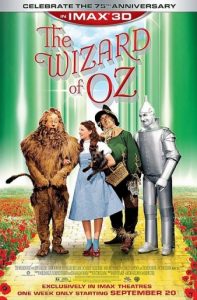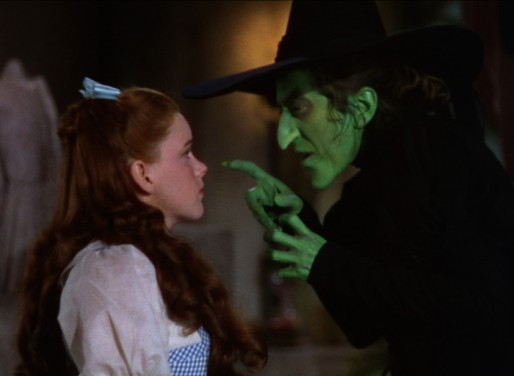
The Wizard of Oz is my favorite movie. Period. It has everything I like about a great adventure or musical — memorable characters, catchy tunes, quests, a really evil character, comic relief, amazing special effects (for the time), a talented lead actress and even flying monkeys. Imagine my surprise when I learned that they were going to rerelease the film in IMAX 3D a few months short of the 75th anniversary of the 1939 movie. I thought that the movie company was just trying to cash in on the success of IMAX conversions, and to some extent, this is actually true. 3D effects add nothing to this film, but it’s a joy to see The Wizard of Oz: An IMAX 3D Experience on the big screen instead of the numerous viewings on a TV screen.
We were one of those families that rushed home if we weren’t there already to watch the annual airing of The Wizard of Oz on TV, usually on some holiday. There were no VCRs or DVRs back then. If you wanted to watch something on TV, you had to be there on time and take bathroom breaks in quick turns during commercials. I never experienced the movie with no interruptions in a theater, so I rushed at the chance to see it in its current run. For most of us, we either watched the entire film on a black-and-white TV set or at least saw the opening Kansas scenes in black and white before the switch to color in Munchkinland. This theatrical release restores the original sepia tones of the film’s Kansas scenes, which works quite well for the switch to color when Dorothy Gale (Judy Garland) opens the door in her crashed house. This release makes a complete cinematic experience in which even the IMAX countdown screen that precedes the presentation and the rating screen (typically blue) following it are in sepia to match the sequences that bookend the movie. Those little details make this more of an experience than just a trip to the theater.
For those of you who have somehow missed this movie over the years, the plot of The Wizard of Oz is an adventure for Dorothy, who runs away from home and tries to return in the middle of a twister just in time for the storm to transport her to the land of Oz. Initially landing in a land of little people with high voices called Munchkins, Dorothy gains the favor of good witch Glinda (Billie Burke) and incurs the wrath of The Wicked Witch of the West (Margaret Hamilton), always on the list of the greatest movie villains of all time. In order to get home to Kansas, Dorothy travels to see the titular wizard (Frank Morgan), meeting and joining three friends along the way known as The Scarecrow (Ray Bolger), The Tin Man (Jack Haley) and The Cowardly Lion (Bert Lahr). Dorothy and her crew need to defeat The Wicked Witch in order for the wizard to help her get home. Unlike many musicals, the songs in the movie feel like the characters would actually sing them on their journey rather than break out in song just to fulfill the requirements of a musical.
The best part of seeing The Wizard of Oz on an IMAX screen is the ability to notice all of the visual details in the film. The makeup of the main characters really holds up at this size. More importantly, you can see every Munchkin in the crowd scenes, whereas a lot of them get cut off on traditional TVs. It still amazes me that the entire Munchkinland sequence only lasts between 10 and 15 minutes. It’s certainly one of the fan favorite parts of the movie. The backdrops at the edges of the sets are more obvious in IMAX, but they’re still surprisingly detailed and colorful. The special effects even hold up well with the flying monkeys’ wires not visible and the tornado not looking at all like the piece of spinning fabric that they used to achieve the effect. The Wizard of Oz in IMAX is every bit the adventure it always was, and the close proximity of the characters and scenery really pulls you in. The IMAX version also helps dispel one of the enduring myths about the movie for many years. In the shot when Dorothy, The Scarecrow and The Tin Man dance down the Yellow Brick Road away from the cottage of The Tin Man, some movement in the background was rumored to be a little person who had hung himself from one of the set’s trees. In fact, it’s a giant bird (crane perhaps?) spreading its wings. Ahh… technology. I would still like someone to explain where the Red Brick Road goes that’s intertwined with the Yellow Brick Road in Munchkinland.
Most IMAX theaters come with booming sound systems, and those speakers also tend to suck you in to the experience. When the tornado nears, you can hear the wind all around you. When Garland sings the signature song “Over the Rainbow,” it will bring a tear to your eye just like any power ballad performed on one of the singing competition TV shows. The joy of the other numbers is more palpable, and the screechy lines of The Wicked Witch send a chill to the bone. Those bits of dialogue from her usually affect people that way. With an excellent sound system, you might also notice some of the flaws in the audio tracks. In particular, Buddy Ebsen was famously replaced as The Tin Man when he developed an allergic reaction to the toxic silver dust used in the makeup. You can hear Ebsen’s voice — not Haley’s — in “If I Only Had the Nerve” and a couple of reprises of “We’re Off to See the Wizard.”
I was impressed with this rerelease of my favorite film. Sure, its run is timed to increase interest in the 75th anniversary edition of the film on DVD and Blu-ray. Sometimes, brash marketing tactics might actually benefit the consumer. The Wizard of Oz is one of the most quoted properties in all of entertainment, and you’ll recognize every famous line of dialogue even if you haven’t watched the film in a while. The Wizard of Oz: An IMAX 3D Experience clearly reestablishes itself as my favorite movie and will likely pick up some new fans who now don’t have to wait for its annual broadcast to return to Oz and enjoy the spectacle.



